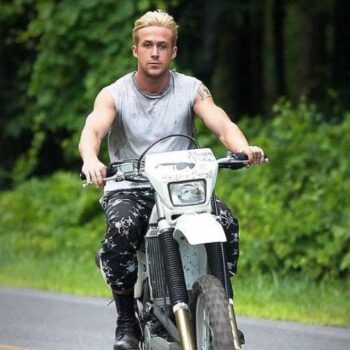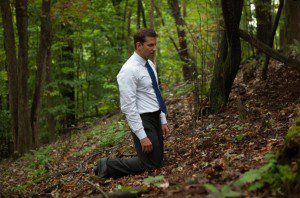
The Place Beyond the Pines begins with a long tracking shot, and the shot acts as a summary of everything that’s good about the movie: its confidence, its ambition, and its meager but distinct accomplishments. It opens on a shirtless Luke (Ryan Gosling) nervously flipping a butterfly knife in a trailer, and follows him as he makes his way outside to the fairgrounds of the traveling carnival for which he works as a motorcycle stunt rider, through the whirling calliope music and the murmuring and shrieking of the night crowd, as he dons a T-shirt and jacket, smokes a cigarette, and approaches the tent where his show will take place, the voice of the emcee growing louder as he hypes the crowd for the arrival and performance of the fearless and legendary Luke, carnie heartthrob and cool-eyed daredevil. The shot stays with Luke as he mounts his motorcycle, then he disappears briefly from the frame as the camera pans to the spherical steel cage which we see him entering with two other riders to perform the harrowing stunt.
The shot is technically simple, but builds like a drumroll, and it conveys the seedy energy of the carnival crowd and the cheap, bountiful thrills of summer nights; it captures Luke’s tawdry but undeniable glamour and the small towns where it thrives; and it establishes Luke as a man willing to take chances, a man totally immersed in the strange and specific life he’s built for himself, a man who seems to have a calm, matter-of-fact approach to danger and love and almost everything else.
After the show, Luke discovers that a fling he had the previous year, when he last passed through town, has produced a son. He decides that he, the baby, and the mother, Romina (Eva Mendes), should be a family (“My father was never around me, and look how I turned out,” he warns Romina), and he quits his carnival job to try to win her back from Kofi (Mahershala Ali), her current boyfriend and a committed father to the baby. But when Luke has trouble finding enough work, he takes to robbing banks.
This opening section is one of three related plotlines, and it’s by far the strongest. It’s hard not to wonder what this movie might have been if director and co-writer Derek Cianfranco had limited himself to a smaller-scale study of character and place, instead of reaching for an epic. This section stands out because of Gosling, of course. He does his Gosling thing—the brooding, the easy charm, the torso—but he manages, in his minimalist way, to give Luke nuances that are almost too good for such a sloppily written film: For example, when he’s robbing a bank, Luke’s voice rises into a shriek bordering on panic—he seems distinctly desperate in a way the Kid, his character from Drive, never was. And in the hours after he’s pulled off a job, he’s cocky, self-assured again, he revels in it. Even after he’s gotten away with several robberies and his partner wants to quit, Luke wants to do more; he’s almost frenzied in his insistence. It’s fair to ask where the need to earn money for his baby leaves off and where the thrill of it all takes over, but this tension comes entirely from Gosling, who remains freer from his public persona than his audience may be. We think of him as the coolest guy in any movie, but he’s still willing to exploit the essential strangeness he first showed playing a sociopath in the otherwise forgettable Sandra Bullock thriller Murder By Numbers. The script of Pines is not his equal.
 The second section follows the cop who took Luke down, Avery (Bradley Cooper). After his act of heroism, Avery finds himself in the spotlight, a celebrated cop with a bright future, and then before we know it he finds himself pulled into department corruption. Stopping Luke was largely a matter of luck, but exposing the crooked cops around him is more calculated, and Avery, who has a law degree but chose to join the police force out of a sense of idealism, parlays it into a promotion to assistant D.A.
The second section follows the cop who took Luke down, Avery (Bradley Cooper). After his act of heroism, Avery finds himself in the spotlight, a celebrated cop with a bright future, and then before we know it he finds himself pulled into department corruption. Stopping Luke was largely a matter of luck, but exposing the crooked cops around him is more calculated, and Avery, who has a law degree but chose to join the police force out of a sense of idealism, parlays it into a promotion to assistant D.A.
In other words, the second section of Pines boils down to a fairly rote tale of ambition, but it’s a half-built contraption at best. Part of the problem is Cooper, who’s a reliable actor doing a reasonably good job of not becoming the next Matthew McConaughey, but who remains better at nailing single scenes than he is at making those scenes hang together into something larger. He makes Avery earnest, kind, and idealistic almost to naiveté, but he fails to add any note of darkness of ruthlessness that would explain his aggressive career maneuvering and eventual transformation from devoted father and husband to icy political climber and eventual divorcé. He isn’t helped by the script, which lacks a moment when that pivot happens, the moment when Avery has to choose sides, and chooses wrong (Michael Corleone at the hospital with Vito and whispering, “I’m with you, Pop. I’m with you.”).
The third act is where Cianfranco tries to bring it all together, but by then the story’s momentum is long gone. The story flashes forward 15 years, and the two babies are grown and, in a coincidence that almost works, become high school friends.  The two actors here are exceptional, especially Emory Cohen, who plays Avery’s son, AJ. Like Gosling, he brings a great deal more to the role than is written, but again, it only serves to underscore the movie’s shortcomings: Cohen’s performance swings between his scenes with friends, when he’s all rich kid bravado and goombah posturing, and a handful of scenes with his absentee father, where the pain of neglect and rejection is written all over his face. But the movie hasn’t taken the pains to explain or even show us that neglect, and because we understand so little about Avery’s decisions and emotions, these scenes lack the punch Cianfranco obviously intended them to have. By the time the pieces have all moved into place for a calamitous reunion of these characters, you’ll be lucky if your interest holds out, never mind your emotional involvement.
The two actors here are exceptional, especially Emory Cohen, who plays Avery’s son, AJ. Like Gosling, he brings a great deal more to the role than is written, but again, it only serves to underscore the movie’s shortcomings: Cohen’s performance swings between his scenes with friends, when he’s all rich kid bravado and goombah posturing, and a handful of scenes with his absentee father, where the pain of neglect and rejection is written all over his face. But the movie hasn’t taken the pains to explain or even show us that neglect, and because we understand so little about Avery’s decisions and emotions, these scenes lack the punch Cianfranco obviously intended them to have. By the time the pieces have all moved into place for a calamitous reunion of these characters, you’ll be lucky if your interest holds out, never mind your emotional involvement.
Oh, and back to that opening shot: It doesn’t just capture everything that’s good about Pines, it captures all its failings, too. It telegraphs the greatness Cianfranco is striving for, because long tracking shots have been a badge of indie style and credibility ever since Orson Welles pushed his camera through the streets of Venice Beach, CA in 1958 for the electrifying opening shot of Touch of Evil. But if you’re going to announce yourself in that way, if you’re going to put yourself in the company of Welles and Scorsese and Tarkovsky, the audience is going to expect a lot. Ambition is a good thing. Pines simply isn’t up to the task.




